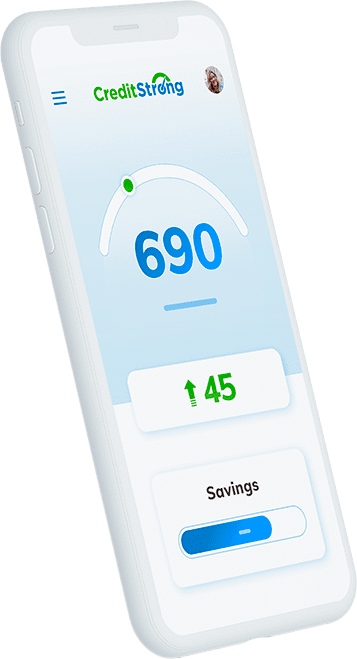The Best Way to Pay Off Credit Cards to Improve Your Credit Score

Build strong credit
while you save

Credit cards are one of the most popular payment methods for their convenience, interest-free grace period, and cashback rewards. However, using them means taking on credit card debt, and how you pay it off significantly impacts your credit score.
Let’s explore the various approaches to repaying your card balances and determine the best way to improve your credit score.
Credit Score Factors To Keep in Mind
There are two primary credit score factors to pay attention to when managing your credit cards. Let’s discuss what they are and their implications when you’re trying to build credit.
Payment History
Your payment history is a track record of your previous monthly debt obligations and whether or not you’ve completed them on time. It’s worth 35% of your score, which makes it the most impactful factor in the FICO algorithm.
To optimize your credit, you must make the minimum monthly payment on all your cards each month. Missing even a single one can harm your score significantly and stay on your credit report for seven years.
However, that doesn’t make it wise to avoid using your credit cards altogether. It may eliminate the risk of late payment, but it also prevents you from building a positive history, which is essential for improving your credit scores.
Credit Utilization
Your credit utilization equals your credit card balance divided by your credit limit. It falls under the amounts owed scoring factor, which is worth 30% of your FICO score and the second most impactful variable in the formula.
Generally, a lower credit utilization ratio makes you look like a safer borrowing prospect to a lender or credit card issuer and increases your score. It indicates that you’re using your credit cards responsibly and aren’t at risk of overextending financially.
Aim for a utilization ratio between 1% and 10% for the best results. Once again, you want to show that you’re keeping your balances low but still actively using the account. A 0% utilization rate is better than overspending, but it’s not optimal.
How To Pay Off Your Credit Cards
If you have outstanding balances across multiple credit cards that you can’t repay at once, there are several approaches to paying them off over time. Here are the most popular options to consider.
The Avalanche Method
The avalanche method involves making your minimum credit card payments on time, then putting all spare cash flow toward the account with the highest interest rate. Once you pay off the first, continue down the line until you’re debt free.
For example, say you have three credit cards with the following balances, interest rates, and minimum monthly payments:
- Card A: $2,800 at 14% with a $60 payment
- Card B: $4,200 at 23% with a $100 payment
- Card C: $5,600 at 15% with a $125 payment
Assuming you have $500 in monthly cash flow for your debt payments, you’d have $215 left after fulfilling your minimum obligations.
If you favor the avalanche method, you’d put that remainder toward Card B until you paid it off in 15 months. Once you’ve eliminated that balance, you’d pay off Card C next, then finish with Card A.
Because it prioritizes the account with the highest interest rate, the avalanche method minimizes your time in debt and interest costs. It also improves your credit score the fastest, all things being equal.
In this case, it would get you out of debt in two years and six months, during which you’d accrue $2,874 in interest.
The Snowball Method
The snowball method also involves making your minimum monthly payments and putting all spare cash flow toward one account until it’s gone, then moving down the line until you’re out of debt. However, it prioritizes the account with the lowest balance.
For example, say you have the same credit cards from the previous section, which include:
- Card A: $2,800 at 14% with a $60 payment
- Card B: $4,200 at 23% with a $100 payment
- Card C: $5,600 at 15% with a $125 payment
Assuming you still only have $500 per month for your debts, you’d put the extra $215 toward Card A first. It would take you ten months to pay off the balance, after which you’d focus on Card B and then Card C.
Because it prioritizes the account with the lowest outstanding balance, the snowball method lets you pay off your first card sooner than the avalanche method. However, it also means more time in debt, higher financing costs, and slower score improvement.
In this case, you’d eliminate your first credit card five months faster, but you’d stay in debt for a year longer and pay an extra $348 in interest.

Debt Consolidation
Debt consolidation is an entirely different approach to paying off credit card debts that involves taking out a new credit account. You use the proceeds to pay off your existing balances, then repay the new debt in place of the old ones.
Debt consolidation makes the most sense when you can qualify for a new account with more favorable terms. Typically, that means reducing the following:
- Overall interest rate
- Total monthly payment
- Time to debt freedom
- Total financing costs
Consumers usually use a personal loan or a 0% interest balance transfer card to pursue these benefits. However, it’s not always possible to accomplish them all at once. You may need to sacrifice in some areas to get the relief you need in others.
In addition, you typically need a good to excellent credit history to qualify for a low-interest personal loan or a 0% interest balance transfer card.
For example, say you have the same credit cards from above, which have a total balance of $12,600, a weighted average interest rate of 17.4%, and a combined $285 minimum monthly payment.
Assuming you can only afford the minimum payments, it would take you seven years and three months to become debt free. During that time, you’d incur $8,339 in interest.
However, you have a good credit score and refinance into a $12,600 personal loan. It has a lower interest rate of 8%, a five-year loan term, and a $255 minimum monthly payment.
You’d reduce your minimum payment by $30, get out of debt two years earlier, and save a whopping $5,610 in interest.
Does Paying Slowly Help Your Credit?
Generally, the more timely payments you make, the better your credit score. As a result, you might think paying your credit card debts back slowly is to your benefit when building credit, but that’s not the case.
The payment history factor only considers whether you make your full monthly payments on time. The size of those payments doesn’t affect it, nor does the size of the balance you’re repaying.
As a result, paying back a large credit card debt slowly doesn’t benefit your payment history. However, it negatively impacts your amounts owed and artificially increases your credit utilization.
Remember, it’s best to keep your balances between 1% and 10% of your available credit limit to optimize your credit score. If you can afford to pay off your debts every month and keep them within that range, then your score will only benefit.
Even if maintaining a higher credit card balance did improve your score, the interest rates on credit cards are too high to make it worth it. It’s always best to pay off your statement balance and avoid accruing charges.
Why You Want To Avoid the Minimum Payment Trap
The best way to use a credit card to build credit is to spend within your means and pay off your statement balance each month. That way, you’ll optimize your payment history and credit utilization while avoiding interest charges.
The worst mistake you can make is to overspend and get stuck making minimum payments toward your debts.
Every credit card company must set minimum payments high enough to cover interest costs, but they often barely clear that requirement. As a result, paying them can trap you in debt indefinitely and ruin your finances.
Fortunately, you can make much faster progress by incrementally increasing your monthly payments.
For example, say you have a $4,000 balance on a credit card with an average interest rate of 16%. Its minimum payment equals the monthly interest charge plus 1% of the outstanding balance, which equals $93.
Assuming you made no additional purchases on the card, it would take you 20 years and six months to pay off that balance by making minimum payments. During that time, you’d incur $4,793 in interest.
However, if you increased your monthly payment to $150, which is only $57 more, you’d get out of debt in 34 months and pay just $976 in interest, which is a massive difference.
Which Strategy Is the Best for You?
Each debt repayment strategy has merit, so the best depends on your circumstances and preferences. Let’s look at each one to help you decide which to choose.
If you have the credit score to qualify for debt consolidation, it’s worth investigating first. Refinancing your credit cards into a personal loan can significantly improve your terms.
Consolidating into a 0% balance transfer card can also be beneficial, but it’s riskier. You’ll forestall all interest charges for about 18 months, but your interest rate will rise to typical credit card levels afterward if you don’t pay off your balance.
However, consolidation has a complicated effect on your credit. You’ll lose points upfront for incurring a hard credit check, lowering the age of your accounts, and likely raising your credit utilization.
That said, the financial benefits are often worth it, and your score will be better off in the long term if consolidation saves you from missing monthly payments.
Meanwhile, if you have a bad credit score and can’t qualify for debt consolidation, the avalanche method is the most efficient. Targeting the card with the highest interest rate minimizes your financing costs and time in debt, improving your score the fastest.
However, the debt snowball method lets you pay off your first account faster. That early reward can help you build momentum and incentivize you to keep going.
If you need the additional motivation that paying off an account provides to stay disciplined with your payments, then the snowball method may be superior.
CreditStrong’s Revolv account can help you improve your score without the financial risk that comes with credit cards, and there’s no credit check when you apply. Give it a try today!
CreditStrong helps improve your credit and can positively impact the factors that determine 90% of your FICO score.
